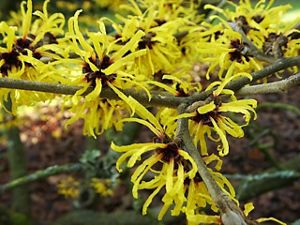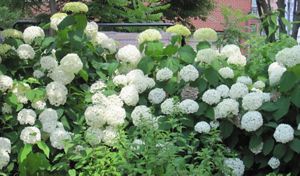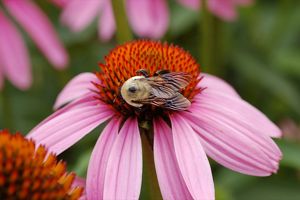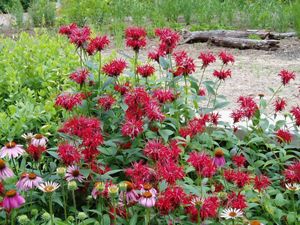A tour of our garden can begin just outside TNC’s back doors. Here, you may catch a variety of perennial wildflowers in bloom in the long, curved bed straight ahead. Many of these plants are in the aster family and bloom in summer. These include the black-eyed susan, Maryland’s state flower, the purple coneflower (also known as echinacea) and various species of coreopsis. The more subtle purple nodding flowers in front are wild onions in the lily family. Midsummer blooms include the tall, showy, bright pink garden phlox—native to Virginia and commonly used as a garden flower—along with the bright red beebalm. Later on, the blazing star, with its purple and white spikes, will burst onto the scene. And now is the time to start looking for the American goldfinches, bright yellow birds that love to eat the flower seeds here. As you wander through the garden, look for rabbits, squirrels and the occasional chipmunk that also make their homes here.
To your right up the steps, the native sweetbay magnolia trees bloom through early summer, in contrast to earlier flowering cultivated species. The garden area around the birdbath has a selection of various shrubs, including sumac, spicebushes, deciduous azaleas and hydrangeas, along with various ferns, sedges and other ground covers. Next to the steps are obedient plants, which will have white flower spikes in late summer. Our compost tumblers are almost hidden behind the large, white hydrangea flowers this time of year. Most of the garden waste is composted on site as we weed and prune—food scraps from the office are processed in the tumblers.
Follow the winding path away from TNC’s building and on both sides is a selection of flowering perennials, grasses and sedges. In the area between the two curved paths, the summer blooming flowers include various species of asters, perennial sunflowers, black-eyed susans, purple coneflowers and Joe Pye Weed. The orange butterfly weed (a milkweed) and common milkweed, which is spreading amazingly well, will hopefully help the monarch butterflies thrive, as they only lay their eggs on milkweeds. In addition, we have one American chestnut tree, donated by The American Chestnut Foundation and planted here in 2008—this particular tree has been bred to resist the blight that attacked all American chestnut trees, most of which died, in the early 20th century.
On the left side of the path in our central meadow, note the two evergreen trees toward the back—these are eastern red cedars and provide excellent habitat and food for birds. Behind the cedars are some yuccas which get a single tall spike of white flowers. The slight hill there allows us to plant a wider variety of plants because the hill will be drier than the lower areas. Water-loving plants, such as iris and swamp sunflower, are in the lowland area, and drought-tolerant plants, such as black-eyed susans, and orange butterfly weed are higher up. In mid to late summer, look for the native hibiscus in the lower area toward the bee house, as it has huge scarlet flowers when blooming. Taller grasses are added throughout the central meadow for variety; and switchgrass, the light, airy one, has been successfully used as a large scale filtration device to stop soil erosion. Fun fact: Switchgrass is also being researched for its use as biomass energy to replace coal and other non-renewable energy sources.
Along the back walk you will see a group of trees with a whitish, papery, peeling bark. These are river birches, the southernmost American species in this mostly boreal genus. (The related paper birch of the north woods has thicker, layered bark strong enough for canoe building.) The large hydrangea flowers stand out even in the deep shade at the back, and go from white to greenish pink as summer progresses. Tall, yellow flowering cup-plants grow on the north side of the path under the birch, while the tall, white flowered yuccas are on the left.
Continuing along toward the trellis, look up at the redbud trees, above the roses. These bloomed in early spring, and now have many hanging seed pods, which hint at why these trees are classified in the pea family. Just behind the roses, the large shrubs with tall cream flower spikes are aptly called bottlebrush buckeye. The square area on the left has our white oak tree, the leaf of which is on The Nature Conservancy’s logo. Surrounding our oak is a mix of more perennials, including the attractive Golden Mosa goldenrod, which starts blooming in mid-summer. The trellis is covered with trumpet creeper, a locally native vine with large orange flowers that attract hummingbirds. Behind the benches are a variety of mostly spring-blooming woodland perennials under the shade of serviceberries and American hollies.
Walking back toward TNC’s building, note the many trees on your right that were planted just a few years ago and are now thriving. The yellowwood and red maple were chosen for their brilliant fall color, and the maple now provides more afternoon shade on the patio. The flowering dogwoods, Virginia’s state tree, and the serviceberry trees provide plenty of food for the birds with their many berries. Summer blooming perennials here include tall coreopsis, yarrow, purple coneflower, and ironweed among others. Closer to the building is a collection of mostly shade spring blooming perennials, with some exceptions: cardinal flower is a mid-summer bloomer with bright red spikes of flowers, and jewelweed is an annual that freely reseeds, and has unusual orange flowers that bloom from mid to late summer. Jewelweed is closely related to the common garden plant, impatiens, and has the same type of seeds that burst open when touched at the right time, hence its other name, touch-me-not.














